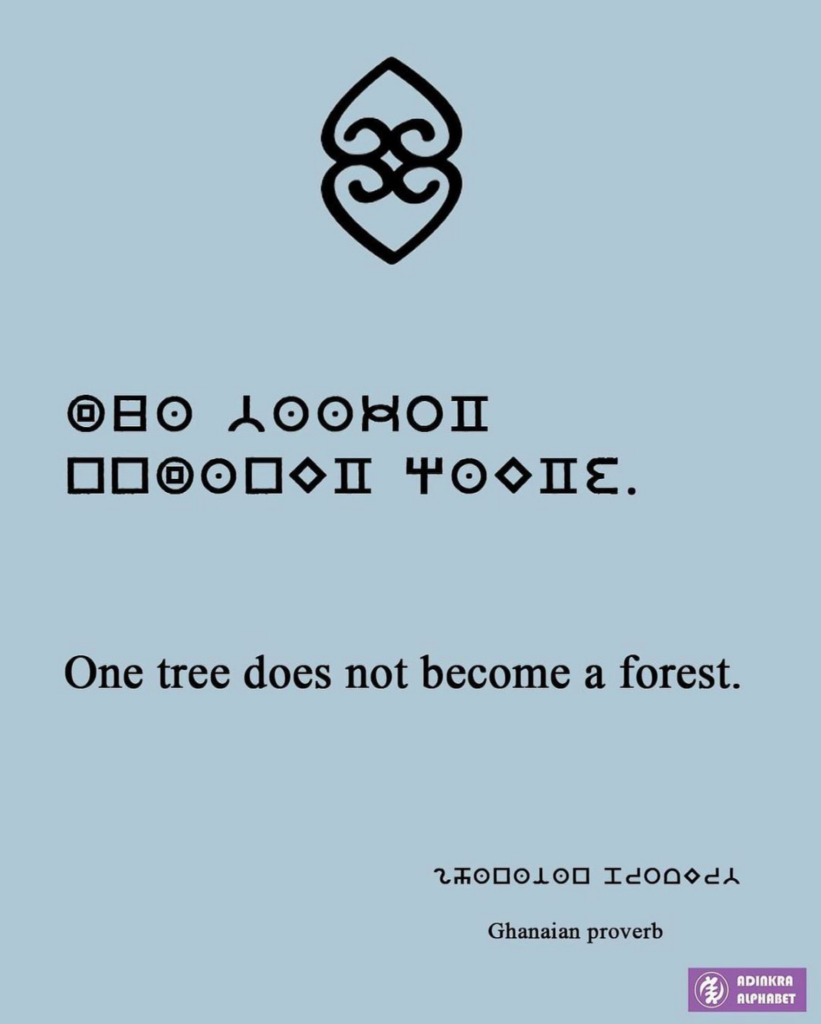The Adinkra Alphabet is a remarkable attempt to reconcile the old with the new, or perhaps to grow the new out of the old. It is also one of only (at the moment) two scripts that are trying to use traditional African ideographic symbols—in this case, the Adinkra symbols of Ghana, each of which stands for a piece of proverbial wisdom—as the basis for phonetic letters that represent individual sounds of speech and can be combined as words and sentences.
(See also the Akagu script, a parallel effort to convert the Nsibidi symbols of Nigeria into an alphabet.)
At once I feel obliged to editorialize for a moment, or at least to illuminate this effort from a different direction.
For centuries, European colonial cultures have regarded pictographic and ideographic systems—that is, forms of visual communication that involve what we would call drawings or graphics—as backward and primitive. In fact, an entire and utterly specious theory of evolution was based on this belief, claiming that as a culture “evolved” from the savage to the civilized, its forms of visual communication also evolved from pictograms to ideograms and then syllabaries to alphabets. This was a racist, circular and self-aggrandizing argument: we use an alphabet, the argument ran, and we are the most evolved race, so the alphabet must be the most evolved form of written communication.
In fact, neither a graphics-based system nor a verbal system is superior; each conveys certain kinds of meaning more clearly or immediately than the other, and under many circumstances (road signage, for example) the two work together very well.
It’s a massive mistake, then, to think of the Adinkra Alphabet as a modernization or an improvement of, or a potential replacement for, the traditional Adinkra symbols.
Instead, let’s consider the description provided by Charles Korankye, the script’s initial creator, in the Adinkra Alphabet Encoding Committee’s proposal to have the alphabet included in Unicode:
“Adinkra symbols have been in existence for many years and are used throughout the world. Adinkra symbols are used by the Akans of Ghana and Cote d’Ivoire with a total population of over 25 million. Some scholars date the origin of Adinkra symbols to the early 18th century. Adinkra symbols are used in writing and as pictographs and logographs. Adinkra symbols are an Akan and Ghanaian heritage. Adinkra symbols are used in stamped cloths by Ghanaians.”
The Adinkra symbols are therefore both popular and deeply rooted in their culture, but they face two drawbacks. One: like many traditional communication systems, they are in danger of being overrun and sidelined by the communications methods and technologies of the West. Two: they have developed as a means of conveying a certain body of cultural wisdom, but as things stand they are limited in scope. The latter is an issue that many endangered languages, written and spoken, face: are they able to fulfill the needs of communication in the 21st century? To be crude, can they express weather forecasts and sports scores? Can they explain calculus and quantum mechanics?
“The creation of Adinkra Alphabet is to standardize Adinkra symbols for ease of writing and make it possible for the wisdom of Adinkra symbols to be thought in schools. Adinkra Alphabet is therefore a continuity of Adinkra symbols and not separate from it.”
The proposal goes on to put its finger on an issue of primary importance facing minority languages and scripts: the generation gap.
“Adinkra Alphabet grew in popularity since its creation in 2015 as it is used by lovers of Adinkra symbols in the same way as they use Adinkra symbols. There is however a generation gap as Adinkra symbols are used by older and more traditional Ghanaians and Adinkra Alphabet is used by the younger generation. Adinkra Alphabet carries all the meanings of Adinkra symbols with an added unique phonetic sound and numerical value.”
The creation of such an alphabet was not without its challenges, one of which was that Ghana has four major tribe-based languages: Akan, Ewe, Ga and Dagbani. The original alphabet had 26 characters, corresponding to the 26 letters of the Latin alphabet, but over the next three years the Ewe, Ga and Dagbani requested that additional characters be added to represent the full range of their languages, resulting in a character-set of 42.
Another interesting feature of this transformation was that the Adinkra symbols, like many pictographs and ideographs, are more complex than letters, and in basing letters on some of the Adinkra symbols, the designers created a script that could be called manually demanding.
“The first Adinkra Alphabet characters developed in 2015 required several strokes. As most of the followers handwrite Adinkra Alphabet they requested simplification of the characters requiring fewer strokes. This resulted in the creation of simplified Adinkra Alphabet characters in 2017.”
The grand launch of this modified and expanded script took place on November 6, 2018 at the Teacher’s Hall in Accra, Ghana.
“Present during the launch are Representative of the First Lady of Ghana, Rebecca AkufoAddo, Frankaahene (Chief) of Akuapem Traditional Area, representatives of all the four major ethnic groups, traditional leaders, a representative from the Balm Library of the University of Ghana and journalists.”
It’s safe to assume that the Adinkra Alphabet is still a work in progress, both in terms of the character-set, the letterforms, how it is used, and how it is taught.
Currently the most common use of Adinkra Alphabet is in writing Ghanaian proverbs, poetry, and songs, which are posted regularly on Instagram.

5.6037° N, 0.1870° W